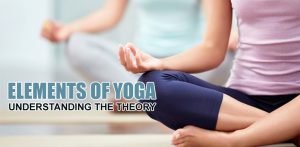Yoga is very important for every person and Yoga is a ideally suited to prevent physical and mental illness and to protect the body generally, developing and inevitable sense of self reliance and assurance. By its very nature it is inextricably associated with universal laws for respect for life, truth and patience are all indispensable factors in the drawing of a quiet breath, in calmness of mind and firmness of will. In this article telling discuss about the Elements of Yoga.

Yoga consists of 8 limbs or stages for the quest of soul.
we will discuss about the Elements of Yoga.
Ashtanga Yoga of Patanjali: The 8 Elements of the Yoga Path
The elements of yoga are as following The Yoga Sutras of Patanjali is considered an equivalent of a Yoga Bible, and for a good reason.
In this relatively short text, written about 2000 years ago, Patanjali reveals the essence of yoga. Yoga is spiritual and defines what yoga is, describes the yoga path, and even warns about the possible dangers on this path.
Without getting into the details, it suffice to say that according to Patanjali yoga helps us to control our mind in order to reach a state of freedom from its these ceaseless activities, and assumptions, ultimately helping us to see the reality for what it is and not what our mind makes it out to be.
In the Yoga Sutras of Patanjali, there are 8 elements of the yoga path. Patanjali is a pure science of collection Note that the physical yoga practice, the asana element, is only one of the 8 elements of the yoga path.
How many elements of yoga are there?
Elements of yoga can be explained. The 8 elements of the yoga path are:
- Yama
- Niyama
- Asana
- Pranayama
- Pratyahara
- Dharana
- Dyana
- Samadhi
Yama
Yama is the first element of yoga and Yama is a type of attitude that a yogi should take towards the world. Yamas are really yogic ethical principles, a set of behaviors with a purpose to help a yogi to be a moral being, a person with consciousness and strong values to live by. Yama consists of five types such as:
- Non-vilence
- Trithfulness
- Non-theft
- Sexual moderation
- Detachment
Niyama
Niyama is a type of attitude that a yogi should take towards oneself. Niyamas are yogic approaches to oneself that are used to build self discipline, will power, determination, and trust in oneself and one’s path. Niyama consists of five types:
- Purity
- Contentment
- Austerity
- Self-study
- Surrender
Asana
Asana is the physical posture in yoga. There are hundreds of asanas used today, many of which are variations on each other with little adjustments and add-ons. This is also physical posture and asanas can be of easier type, suitable for all levels, and they can get harder and harder as one progresses in his or her practice. However, all asanas have to be practiced with a certain attitude.
Pranayama
Pranayma is a type of yogic breathing exercise used to prepare a yogi for meditation. There are so many benefits of pranayama and positive effects on one’s body and one’s mind. First of all, pranayama helps a yogi to improve his or her breathing pattern. Second, pranayama allows for more oxygen to feed the brain, improving its functions, especially its capacity to stay awake and concentrated (for meditation and introspection). It helps a person become more conscious of the breath, of the body, and of the mind, bringing in more awareness of oneself as a result.
Pratyahara
Pratyahara is translated as the “withdrawal of the senses”. Pratyahara is also sense and It is a natural process that occurs when a person is extremely aware of oneself in the present moment, completely concentrated and absorbed in one’s activity. It is something that artists and other creative people refer to as “the flow”: being so focused on one’s creative process that everything else disappears and no distractions reach the mind.
Dharana
Dharana is a type of single-pointed concentration. Dharana is a mental fixation but also the flow of consciousness is directed exclusively towards one object (internal or external) and is sustained there for a long time. This type of mental fixation should be uninterrupted and without interfering mental activities of any kind. As you can imagine, dharana is something that takes years of practice and determination for most of us, although some people are born with an innate ability to concentrate like that. Some people, due to their profession, also may develop this type of concentration.
Dyana
Dyana is meditation.It is a technique of Meditation used to calm down and control the mind, limiting its activity, reaching a state of high concentration, focus, and ultimately – awareness of oneself. When the mind is completely quiet and no mental activity disturbs a yogi, a certain state is reached, a state in which one taps into one’s essence, underneath all of the layers and layers of conscious and subconscious mental representations that have to be eliminated. Meditation is really not something that you do, it is rather something that happens when all the conditions for it are met.
Samadhi
It is also the element of yoga and Samadhi is probably the most mysterious, misused, and misunderstood element of the yoga path. It is definitely something that, in its initial stages, completely personal as to the way one can experience it and describe it. Hence, all of the confusion. It is a state beyond words and beyond mental concepts. This is why metaphors, poetry, and art have been the best mediums for the descriptions of samadhi.
Justin Gatlin
| Personal information | ||||||||||||||||||||||||||||||||||||||||||||||||||||||||||||||||||||||||||||||||||||||||||||||||||||||||
|---|---|---|---|---|---|---|---|---|---|---|---|---|---|---|---|---|---|---|---|---|---|---|---|---|---|---|---|---|---|---|---|---|---|---|---|---|---|---|---|---|---|---|---|---|---|---|---|---|---|---|---|---|---|---|---|---|---|---|---|---|---|---|---|---|---|---|---|---|---|---|---|---|---|---|---|---|---|---|---|---|---|---|---|---|---|---|---|---|---|---|---|---|---|---|---|---|---|---|---|---|---|---|---|---|
| Nationality | American | |||||||||||||||||||||||||||||||||||||||||||||||||||||||||||||||||||||||||||||||||||||||||||||||||||||||
| Born | February 10, 1982 Brooklyn, New York, U.S. |
|||||||||||||||||||||||||||||||||||||||||||||||||||||||||||||||||||||||||||||||||||||||||||||||||||||||
| Height | 6 ft 1 in (185 cm)[1] | |||||||||||||||||||||||||||||||||||||||||||||||||||||||||||||||||||||||||||||||||||||||||||||||||||||||
| Weight | 175 lb (79 kg)[2] | |||||||||||||||||||||||||||||||||||||||||||||||||||||||||||||||||||||||||||||||||||||||||||||||||||||||
| Sport | ||||||||||||||||||||||||||||||||||||||||||||||||||||||||||||||||||||||||||||||||||||||||||||||||||||||||
| Sport | Track and field | |||||||||||||||||||||||||||||||||||||||||||||||||||||||||||||||||||||||||||||||||||||||||||||||||||||||
| Event(s) | Sprints | |||||||||||||||||||||||||||||||||||||||||||||||||||||||||||||||||||||||||||||||||||||||||||||||||||||||
| College team | University of Tennessee Volunteers | |||||||||||||||||||||||||||||||||||||||||||||||||||||||||||||||||||||||||||||||||||||||||||||||||||||||
| Team | Nike | |||||||||||||||||||||||||||||||||||||||||||||||||||||||||||||||||||||||||||||||||||||||||||||||||||||||
| Coached by | Loren Seagrave | |||||||||||||||||||||||||||||||||||||||||||||||||||||||||||||||||||||||||||||||||||||||||||||||||||||||
| Achievements and titles | ||||||||||||||||||||||||||||||||||||||||||||||||||||||||||||||||||||||||||||||||||||||||||||||||||||||||
| Personal best(s) | 60 m: 6.45 (Boston2003)[3] 100 m: 9.74 (Doha2015)[4] 9.87 (Stanford2019)35≤ WR (2019) 200 m: 19.57 (Eugene2015) |
|||||||||||||||||||||||||||||||||||||||||||||||||||||||||||||||||||||||||||||||||||||||||||||||||||||||
|
Medal record
|
||||||||||||||||||||||||||||||||||||||||||||||||||||||||||||||||||||||||||||||||||||||||||||||||||||||||



























